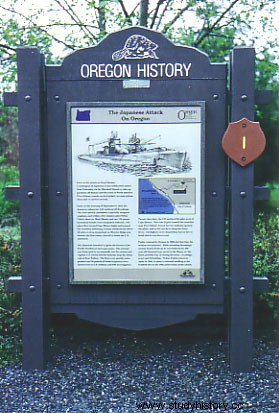On February 23, 1942 the submarine I-17 of the Imperial Japanese Navy, which had participated in the attack on Pearl Harbor, bombarded the American coast causing damage to an oil refinery in Santa Monica (California). Before the army could react, the submarine submerged and disappeared. The Japanese had dared to attack the continental part of the United States, signs of panic followed one another and the fear of an air attack like Pearl Harbor spread among the population. But nothing else happened… that day. On September 9, 1942, the Japanese submarine I-25 emerged in Pacific waters off the Oregon coast... the US was going to suffer the first and only aerial bombardment in history.
The I-25 was an aircraft carrier submarine that carried a Yokosuka E14Y two-seater seaplane inside. . On the morning of September 9, the submarine's captain ordered the seaplane to be brought outside, its wings and tail unfolded, armed with incendiary bombs, and placed on the launch catapult. The pilot Nobuo Fujita and crew member Shoji Okuda they had the mission of causing devastating fires in the forests to maintain fear among the civilian population and demonstrate Japanese power -no one had dared to bomb the US on continental soil... until now-. The catapult launched the seaplane, and Nobuo Fujita headed for the Oregon woods. When they reached the chosen area - the woods around the town Brookings -, released the bombs and after verifying that the fire had started, they turned 180° and returned. They splashed down in the ocean and reached the submarine; after refolding the wings and tail of the plane, they submerged and disappeared. The execution of the mission had been perfect, but not so the final objective:the forest was very wet due to the recent rains and, in addition, a forester had spotted the seaplane over the forests and had been able to give the warning signal to extinguish the fire on time.

Although Nobuo Fujita did nothing but carry out the orders received in the middle of a war, that bombardment tormented him for 20 years... until in 1962, on the occasion of a local holiday, the Brookings authorities invited him to visit his town as a sample of friendship between the Japanese and American people. Nobuo Fujita was going to have the chance to ask for forgiveness and redeem his conscience, but he, too, was uneasy about how he was going to be received. Being a man of honor and willing to do anything, he took the 400-year-old family katana with him to, if necessary, appease the fury of the Americans by committing ritual suicide – harakiri or seppuku -. When he arrived all doubts about him were dispelled, he was received like a celebrity. Grateful for the signs of affection, he apologized for what happened 20 years ago, gave his samurai sword to the people -today it is still on display in the library- and, in addition, donated a $1,000 check to buy books about Japan so that both peoples know better and that there would never be another war between them. Among the activities scheduled for that day, Nobuo Fujita was able to fly over the forests of Brookings and even fly the plane himself. On the day of his departure, he promised to finance a trip for village children to visit Japan.

Unfortunately things went wrong and Nobuo Fujita's company went bankrupt. Still, he was a man of honor and he was going to keep his word… for more than 20 years he was saving yen by yen until he had enough money. In 1985, three young people from the town (Robyn Soifeth, Lisa Phelps and Sarah Cortell) traveled to Japan. In 1997, at the age of 85, Nobuo Fujita passed away and the Brookings authorities made him an "citizen of honour «.

Sources:The New York Times, Chicago Tribune, Oregon History
